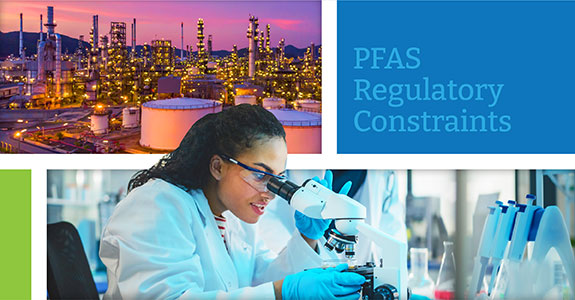
PFAS: Regulatory Constraints from both an Analytical Methodology and Regulatory Perspective
March 8, 2022
By: Martha Maier
Part 3 of a special, four-blog series
As you’ve probably noticed from recent blog posts and online sources, proposed and pending PFAS regulation changes have been a hot topic for conversation – and speculation. But regulations aside, there hasn’t been much talk about measurements of PFAS, despite the impact they have on the overall landscape. But before I start to cover some of the important changes and considerations that are on the horizon, here are some of the most important developments of the past year that have led us to this point.
Recent PFAS Observations & Notable Developments
- Development of Analytical Methods
In July 2021 Method 3512-8327 was published. Considered a screening method, there was concern during the open comments period about precision, bias and sensitivity of Method 8327, the EPA has approved the study data for their Data Quality Objectives. But the single most important release has been EPA Draft Method 1633, which is currently undergoing multi-laboratory validation to test for 40 PFAS compounds including PFOS, PFNA, PFOA and PFBS – being instrumental in the investigation and/or remediation of PFAS in soil, surface and ground water, biosolids, landfill leachate or sediment. While this method isn’t required for Clean Water Act compliance at this time, the EPA is encouraging the use of this method to review, as once the method has been promulgated through rulemaking, this will likely become a standard. Currently under review, it is anticipated that this will be published in late 2022 or early 2023.
- Possible regulation of classes versus individual compounds.
Some states are exploring the possibility of regulation by class instead of by compound. This raises questions on how will PFAS classes be defined. This may involve different analytical techniques, such as performing a TOP Assay (Total Oxidizable Precursors) or TOF analysis (Total Organic Fluorine). Validated analytical methods have not yet been developed for these procedures.
This may require a different type of instrumentation and process/planning (total organic fluorine). This also raises questions on how PFAS classes will be defined. This confuses things on an analytical level, as a broad analysis tends to complicate things when procedurally you have been targeting individual compounds.
- Lower detection limits/Increased target analyte lists
We continue to see a push to lower detection limits and increased target analyte lists. The use of Non-Targeted Analysis (NTA) will continue to identify new compounds of interest and will make progress toward becoming targeted analytes as analytical standards become available.
What are some of the things I should know about PFAS from a lab/methodology Standpoint?
- With the emergence of new lab methods such as EPA 1633, how will my data compare with previous data?
If you’re using a DOD certified lab or your lab is following all DOD QC criteria, your data will compare well. If your lab doesn’t/isn’t following these procedures, you may experience some issues. Ensuring that your lab is DOD certified is an easy way to make this less of a headache for yourself.
- How will these changes impact pricing/cost?
Besides procedural changes, changes and improvements in quality control makes it natural that prices will increase somewhat.
- Where does the EPA stand in their work on air methods?
The easiest way to describe this would be as a work in progress. There is a draft of OTM-45, it is in the early days of review and commenting, and EPA has been doing work on ambient testing but at this time no draft method exists.
Do you have PFAS questions, or just want to be up to speed on the latest?
As a panelist on the upcoming PFAS focused webinar The 2022 PFAS Crystal Ball, March 10, 2022 @ 2 PM EST. I’ll be discussing these topics alongside some other experts from the Montrose family. Join us to learn more about your PFAS labs, data and potential impacts, and what’s coming up in the PFAS landscape – what you need to know, and where you can find answers to your questions.
The 2022 PFAS Crystal Ball: What’s Coming, and How You Can Be Ready
A Blog Series and an Informative Webinar
- Part 1: PFAS Regulatory Developments: Concerns, Employee Safety and Community Impact:
What You Need to Know to Stay Ahead of The Curve - Part 2: Current and Future Requirements in PFAS Compliance, Assessment and Remediation:
What You Need to Know and Why - Part 3: PFAS: Regulatory Constraints from Both an Analytical Methodology and Regulatory Perspective
- Part 4: PFAS Remediation: Fundamental Challenges for the Short and Long Term
– coming Wednesday, March 9
 Martha Maier – Enthalpy Analytical Panelist, Vista Analytical Laboratory
Martha Maier – Enthalpy Analytical Panelist, Vista Analytical Laboratory
Martha Maier is the President and Laboratory Director of Vista Analytical Laboratory, located in El Dorado Hills, CA. She earned her BS in chemistry and philosophy at the University of Wisconsin-Madison. She has over 30 years of experience in environmental chemistry, primarily involving high resolution mass spectrometry for the analysis of chemicals such as dioxins, PCBs and chlorinated pesticides. Martha has been involved in the analysis of PFAS since Vista developed their in-house analytical method for serum in 2007. She has been the Laboratory Director since 2002 and became the majority owner in 2011. She is a member of the ITRC PFAS Committee and Sampling and Analysis Subcommittee.

